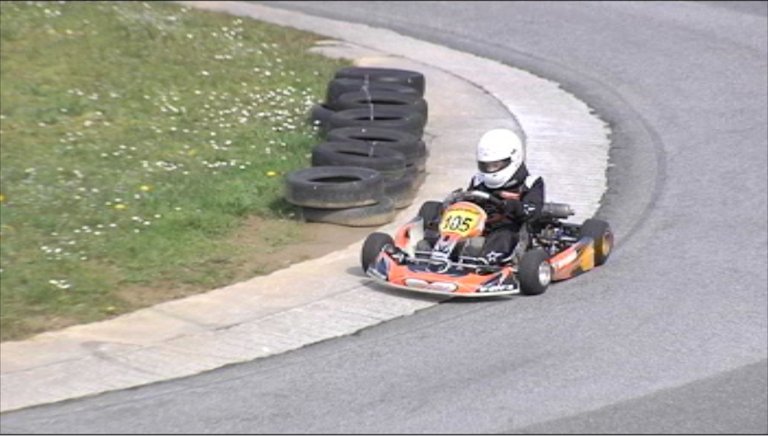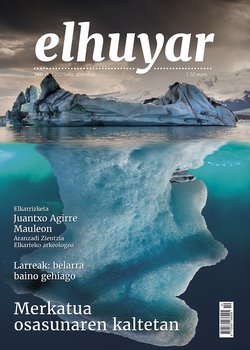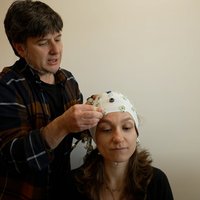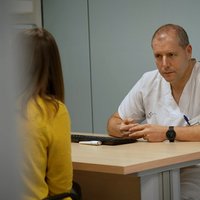At full speed in the Quart

MIKEL NAZABAL; Spirit Racing Team: Let's start with the little one. This is Aritz Murua,
The Abalcian, and his kart and category is the cadet. Below there is another category, the kart is completely the same, the only difference is in the engine: this is of two times, like the rest, in karting the four times are practically not used, and it has 85cc, the albino has 64cc.
NAGORE REMENTERIA; Elhuyar: What general characteristics does it have?
M. According to N.: At this level, it is usually a function of the kart to teach and to adopt the correct habits when driving, in order to better address them in the following levels. The first feature is that it does not have a brake on the front wheels. This means that you have to brake correctly, if you turn the steering wheel a little to the right or to the left the kart leaves from behind. In addition to this, it is automatic, meaning it has no gear, the bow is electric, and the other characteristics are the same as in the other categories: it has no suspension...
In the case of N. A. is: They're tough cars, aren't they?
M. According to N.: Yes, you feel it in your hands immediately as soon as the track touches a piano. It’s very technical in that sense.
In the case of N. A. is: Are the next karts a bit bigger?
M. According to N.: In all the following levels the chassis is the same, in junior and senior. The Juniror kart is like this: automatic, 125 cc... One of the peculiarities of this is that it has one freno on its leg and the other on its hand. You have the rear brake on your leg and the front brake on your hand, with this tool you can choose the distribution of the brakes from curve to curve: how much you want behind and how much in front. We'd go over here to the walking categories. The lever is on the right hand and the clutch is on the left. It's only used to get out of the room. Its power is greater: 50 horsepower. The power-to-weight ratio is very good.
In the case of N. A. What weight does it have?
M. According to N.: About 80-90 kilos. It must be 175 kilos with the driver, according to the regulations.
In the case of N. A. is: And to reach that weight do you add weight or lead?
M. According to N.: Not in this case, but here's another kart. This group guide is Mikel Mostajo, from San Sebastian. As you can see it is quite thin and to reach 175 kilos you have to put lead plates on it. Another difference between the small and the large kart is the cooling system: the small one is dry, the air is channeled through these sheets, and the larger one is made with water and we control it with a radiator.
In the case of N. A. is: What speed can an apparatus like this reach?
M. According to N.: We're not really trying to find a high peak speed. We prepare the kart to have the highest possible speed of curve by curve. Karting circuits tend to have few straights and many curves. If we only prepared this to speed up, it would easily exceed 200 km/h. But there is no point in worshiping.
We have a system installed above the kart called logger. It gives us data such as Mikel’s time in the last race, including maximum revolutions, maximum speeds, maximum temperature and the fastest lap was 7th. To complete all this, we have a GPS system at the front that gives us lateral and longitudinal speeds and accelerations. With all this we represent the circuits in the computer graphically. That’s where we see mistakes. I have two laps here: red is fast and black is a lap that has made seven hundredths more. When we look at the differences, and in the circuit we see that he has taken a curve deeper in one of the laps, he has made a small change in the trajectory. In the video we see what really happened: if the kart leaves, if there has been a driving error...
In the case of N. A. is: So the goal is to make all the curves exactly the same and perfect?
M. According to N.: We try to do that as much as we can. And the search for improvements over and over again: search for improvements, work, search for improvements, work... It has no limits. It’s about winning and making as much difference as possible.
This protection is more important to me than a helmet.
In the case of N. A. is: On the ribs!
M. According to N.: Oh, yeah, yeah. Keep in mind that we don't have any suspense here. If in a kart of this type of competition we were to go 20 laps to the top and without the protection of the ribs, to get out of bed the next day! Then the first protection on the side. The monkey, the collar... The helmets are specially designed for the kartig, they are limited in weight (they are children and have limited neck strength) and allow you to see them on the sides, since the car does not have mirrors. This is the equipment that the driver has to protect: boots, jumper, sidewall protection, gloves and helmet.
Buletina
Bidali zure helbide elektronikoa eta jaso asteroko buletina zure sarrera-ontzian











